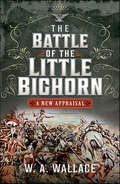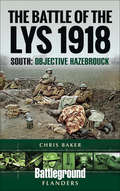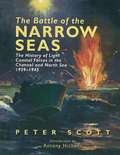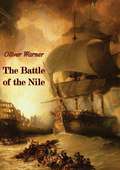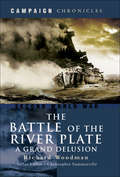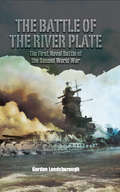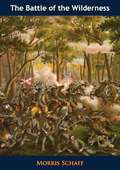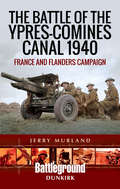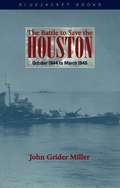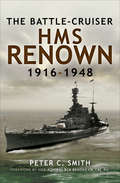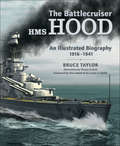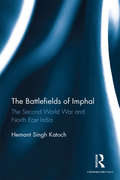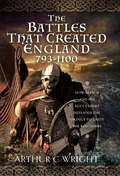- Table View
- List View
The Battle of the Huertgen Forest
by Charles B. MacdonaldAn electrifying account of carnage and bravery...<P> In September 1944, three months after the invasion of Normandy, the Allied armies prepared to push the German forces back into their homeland. Just south of the city of Aachen, elements of the U.S. First Army began an advance through the imposing Huertgen Forest. Instead of retreating, as the Allied command anticipated, the German troops prepared an elaborate defense of Huertgen, resulting in a struggle where tanks, infantry, and artillery dueled at close range. The battle for the forest ended abruptly in December, when a sudden German offensive through the Ardennes to the south forced the Allied armies to fall back, regroup, and start their attack again, this time culminating in the collapse of the Nazi regime in May 1945.
The Battle of the Little Bighorn: A New Appraisal
by W.A. WallaceLt. Col. George Armstrong Custer died at the hands of Native Americans by the banks of the Little Bighorn in Montana 25th June 1876. This is an established undisputed fact. What is disputed is the real reason that he died. So forget all you have been indoctrinated to believe and begin to learn the truth. George Custer was anathema to his superiors, but the populace loved him. If he were to stand for president in the coming elections there was a strong possibility that he would win. Neither William T. Sherman nor ‘Little Phil’ Sheridan could allow that to happen. Thus, they conspired to put Custer in a position in the field where the opposing Sioux and Cheyenne were stronger and could deliver the ‘Coup de Gras’. The first of two volumes to deal with the circumstances that arose leading the Native Americans on a collision course with the US Army that fateful day and the death of a national hero. Subsequently the conspiracy is uncovered and shows how these men used their powers and positions and so deftly covered their tracks. Perhaps, but not quite. 30 years of diligent research has uncovered the truth in this groundbreaking history. Unmissable and shocking, dare you not read this surprising revelation.
The Battle of the Lys April 1918 (Australian Army Campaigns #25)
by Colin MatteyIn the wave of devastating German offensives launched in the spring of 1918, it is Operation Michael that has captured most attention, characterised by astonishing advances and their potentially shattering impact on the British Expeditionary Force’s (BEF) Third and Fifth armies. While this offensive eventually petered out, albeit tantalisingly close to the BEF’s crucial logistic hub of Amiens, German General Ludendorff redirected the German effort north to Flanders to launch Operation Georgette. In Flanders, the BEF front line lay alarmingly close to the vital channel ports, and the main German thrust posed a direct threat to the town of Hazebrouck, the BEF’s second key logistic hub. After four years of grinding and horrific war, all that stood between the Germans and victory was the 1st Australian Division, hastily recalled to defend the town. This volume describes the battle to save Hazebrouck — part of what was to become the Battle of the Lys — and focuses on the role of the 1st Australian Division in halting the surging German thrust towards the town. While often neglected by history, this action was critical to the survival of the BEF and the Allied war effort in 1918 and deserves far greater recognition. The Battle of the Lys also brings the performance of the BEF divisions during Operation Georgette into sharper focus while providing a unique opportunity to reassess BEF and German performances at what was a decisive point in the First World War.
The Battle of the Lys, 1918: Givenchy and the River Law (Battleground I Ser.)
by Phil TomaselliThe battles fought at Estaires and Givenchy, just south of Ypres, in April 1918 were critical episodes in the larger Battle of Lys which determined the outcome of the ultimate German offensive on the Western Front. The massive assault of Ludendorffs armies crashed against defenses manned by the British and Portuguese. A series of intense attacks and counterattacks followed, and the Germans were on the verge of gaining the decisive breakthrough that both sides on the Western Front had struggled for since the onset of trench warfare in late 1914. A German success might well have forced the British to retreat from Ypres. Phil Tomasellis vivid account reconstructs events in the typical Battleground style. He describes the course of the fighting in close detail, using eyewitness accounts, official records, photographs and maps, and he provides walking and driving tours of the battlefield and of the monuments and cemeteries associated with it.
The Battle of the Lys, 1918: Objective Hazebrouck (Battleground Books: Wwi Ser.)
by Chris BakerThe German offensive in Flanders in April 1918 came close to catastrophe for the British Armies, but ultimately ended in strategic defeat for the Kaisers men. Following closely on the heels of the devastating Operation Michael attack in March on the Somme and around Arras, named as Operation Georgette, the offensive was aimed at strangling the vital railways and roads that supplied the British at Ypres.Having assembled an overwhelming numerical advantage, the Germans attacked in thick fog on 9 April 1918. They faced tired British formations that had just been relieved from the earlier battle and which were receiving replacements, mainly in the form of 18 year-old conscripts. By the days end, the Germans had succeeded in gaining a crossing of the River Lys and were well on their way to the vital railway junctions at Hazebrouck. Several British divisions were deployed to stop the advance, only to be effectively destroyed in the attempt over the next few days. Gradually, fresher British, Australian and French reserves arrived and held their ground. With disappointing results, mounting casualties and a diminishing return for their efforts, the Germans abandoned the offensive and turned their attention further south.What the British call The Battle of the Lys 1918 is a fascinating yet curiously neglected period of military history. Chris Baker examines this major battle from the strategic down to the platoon level, highlighting the key events, characters and acts of enormous bravery on both sides, both in a historical narrative and in a series of tours of the area.This volume, one of two on the battle, concentrates on the southern half of the battlefield.
The Battle of the Lys, 1918: South: Objective Ypres
by Chris BakerThe second of two Battelground Europe titles covering this highly significant battle of spring 1918.The German offensive in Flanders in April 1918 came close to catastrophe for the British Armies, but ultimately ended in strategic defeat for the Kaisers men. Following close on the heels of the devastating Operation Michael attack in March, which had been aimed against the British front on the Somme and Arras, this offensive, Operation Georgette, was aimed at strangling the vital railways and roads that supplied the British at Ypres and threatening the vital logistics links with the Channel Ports.Having assembled an overwhelming numerical advantage, the Germans attacked in thick fog on 9 April 1918. By days end, the Germans had succeeded in gaining a crossing of the River Lys and were well on their way to the railway junctions at Hazebrouck. Next day, they extended the attacked front northwards and advanced to the very gates of Ypres, forcing a British retirement from the bloodily won advances during the Third Battle of Ypres. Messines Ridge, captured so spectacularly by the British in June 1917, was soon in German hands and fighting inched towards Mont Kemmel, which dominated the Ypres front. Once this fell, the way was open for the capture of the main supply roads into Ypres.To find sufficient reserves to counter the German attack, the British took the heart-breaking decision to abandon the ground won so dearly in the Passchendaele offensive in the summer and autumn of 1917. Gradually, fresher British and French reserves arrived and held their ground. With disappointing results, mounting casualties and a diminishing return for their efforts, the Germans paused to regroup. Late in the month they unleashed a rapid, unstoppable attack that captured Kemmel from the French forces that had been rushed north to reinforce the threatened line and which had been holding the summit: one of the finest military feats of the Great War.Behind the scenes, however, the Germans were already calling off a continuation of the offensive and so, by a seeming miracle, the bastion that was Ypres remained in British hands.What the British call The Battle of the Lys 1918 is a fascinating yet curiously neglected period of military history. Chris Baker examines this major battle from the strategic down to the platoon level, highlighting the key events, characters and acts of enormous bravery on both sides, both in historical narrative and in a series of tours of the area.This volume concentrates on the northern half of the battlefield; nearly all of the actions described in this volume took place in Belgium.
The Battle of the Narrow Seas: The History of Light Coastal Forces in the Channel and North Sea, 1939–1945
by Peter ScottThis is the story of the struggle for the control of the narrow seas of the Channel and the southern North Sea during the Second World War, told by Peter Scott who, as a MTB commander, saw action against the enemy throughout the course of the War.The book is much more than a memoir and tells the whole story of the wide-ranging conflict against the Germans, fought in the congested waters of the Channel. Actions against convoys and E-boats, often under the shadows of French cliffs, an impossible sortie against Scharnhorst and Gneisenau as they ran the gauntlet through the Straits in February 1942, the attack on St Nazaire, and the defensive and offensive roles taken on by MTBs during the D-Day landings are just some of the events covered in the book.The bravery of the crews of these small ships became legendary and the casualties that were suffered during brief and fierce encounters were horrific. As the War dragged on Motor Torpedo Boats became household words, and their activities, often described, perhaps a little luridly in the press, helped to raise the morale of the nation in much the same way that the fighter aircraft had done in the Battle of Britain in September 1940. A much-needed new edition.
The Battle of the Nile
by Oliver WarnerFirst published in 1960, this is a gripping account of the decisive sea battle between the forces of Napoleon and the British under Nelson in 1798.The Battle of the Nile (also known as the Battle of Aboukir Bay) was a major naval battle fought between the British Royal Navy and the Navy of the French Republic at Aboukir Bay on the Mediterranean coast off the Nile Delta of Egypt from 1-3 August 1798. The battle was the climax of a naval campaign that had ranged across the Mediterranean during the previous three months, as a large French convoy sailed from Toulon to Alexandria carrying an expeditionary force under General Napoleon Bonaparte. The British fleet was led in the battle by Rear-Admiral Sir Horatio Nelson.
The Battle of the River Plate: A Grand Delusion (Campaign Chronicles)
by Richard WoodmanA study and reassessment of the major World War II battle in the South Atlantic between the British and German navies. The Battle of the River Plate was the first major naval confrontation of the Second World War, and it is one of the most famous. The dramatic sea fight between the German pocket battleship Admiral Graf Spee and the British cruisers Exeter, Ajax, and Achilles off the coast of South America caught the imagination in December 1939. Over the last sixty years the episode has come to be seen as one of the classics of naval warfare. Yet the accepted interpretation of events has perhaps been taken for granted and is ripe for reassessment, and that is one of the aims of Richard Woodman&’s enthralling new study.Praise for The Battle of the River Plate: A Grand Delusion &“This author has made it all so very riveting, it really is a book which is hard to put down until finished.&” —Royal Geographical Society &“Graphic, thought provoking—highly recommended.&” —Britain at War
The Battle of the River Plate: The First Naval Battle of the Second World War
by Gordon LandsboroughAt dawn on 13 December 1939, smoke was seen on the horizon; HMS Exeter was told to close in and investigate. Two minutes later a dramatic signal was sent from the British cruiser I think it is a pocket battleship.It was. The Deutschland-class heavy cruiser Admiral Graf Spee, marauder of the South Atlantic shipping, had sailed into a trap. Three smaller British cruisers closed in on a German warship which, so Hitler had boasted, could out-sail any ship powerful enough to damage her, and out-gun any ship able to keep up with her an invincible ship.So began the Battle of the River Plate, story which has its duplicates in British naval history, but which nevertheless brought pride and inspiration into the hearts of a nation unwillingly at war once again.A terrible battle was fought that day off the coast of South America, a naval encounter in the finest Nelson tradition and true to that tradition, victory went to the men with the finest armament of all, courage.This edition will be presented with an Appendix containing the official despatch detailing the Battle of the River Plate.
The Battle of the River Plate: The Hunt for the German Pocket Battleship Graf Spee
by Dudley PopeThis tale of the Battle of the River Plate follows the machinations of the German war machine as Kapitan zur See Hans Langsdorff commands the pocket battleship Graf Spee on a mission to cripple British shipping. Through clever subterfuge and daring, the Graf Spee takes ship after ship, ultimately forcing the British Navy to send twenty ships in search of the elusive German vessel. Pope presents a true, enthralling account of the men, ships, and tactics that culminated in this naval action which so brilliantly began Britain's war at sea.
The Battle of the Somme
by Alan AxelrodFought during 1916, the Battle of the Somme was conceived by the French and British as a great offensive to be waged against Germany even as France poured incredible numbers of men into the slaughterhouse that was the desperate defense of Verdun. The French general-in-chief, Joseph &“Papa&” Joffre, was especially anxious to go on the offensive. For the French high command cherished the belief, born in the era of Napoleon, that the success of French arms depended on attack and that defense was anathema to what the nationalistic philosopher Henri Bergson called the &“élan vital&” of the French people, a quality, he argued, that set the Gallic race apart from the rest of the world. After more than five months, the British eked out a penetration of some six miles into German territory. The cost had been 420,000 Britons killed or wounded (70,000 men per mile gained)—and most of these were from &“Kitchener&’s Army,&” so-called Pals Battalions, working- and middle-class volunteers promised that they could fight alongside their friends, co-workers, and neighbors. This meant that the Somme, more than any other battle before or since, devastated the young male population of entire British towns, villages, and neighborhoods. French losses were just under 200,000. The Germans lost at least 650,000. Just as the French refused to give up ground at Verdun, the Germans held on stubbornly at the Somme—so stubbornly that General Ludendorff actually complained that his men &“fought too doggedly, clinging too resolutely to the mere holding of ground, with the result that the losses were heavy.&”The only thing &“conclusive&” about the Somme was the ineluctable fact of death. No battle ever fought in any conflict provided a stronger incentive for all sides to reach a negotiated peace—the &“peace without victory&” that Woodrow Wilson, still standing on the sidelines, urged the combatants to agree upon. Instead, the Kaiser, appalled both by Verdun and the Somme, relieved Falkenhayn and replaced him with Hindenburg and Ludendorff, who had achieved great success on the Eastern Front. The new commanders created two new defensive lines, both well behind the Somme front. On the one hand, it was a retreat. On the other, it was a commitment to draw the French and British farther east and invite them to sacrifice more of their soldiery. The modest advance the British made was but the prelude to additional slaughter.
The Battle of the Tanks: Kursk, 1943
by Lloyd ClarkOn July 5, 1943, the greatest land battle in history began when Nazi and Red Army forces clashed near the town of Kursk, on the western border of the Soviet Union. Code named "Operation Citadel,” the German offensive would cut through the bulge in the eastern front that had been created following Germany’s retreat at the battle of Stalingrad. But the Soviets, well-informed about Germany’s plans through their network of spies, had months to prepare. Two million men supported by 6,000 tanks, 35,000 guns, and 5,000 aircraft convened in Kursk for an epic confrontation that was one of the most important military engagements in history, the epitome of "total war.” It was also one of the most bloody, and despite suffering seven times more casualties, the Soviets won a decisive victory that became a turning point in the war. With unprecedented access to the journals and testimonials of the officers, soldiers, political leaders, and citizens who lived through it, The Battle of the Tanks is the definitive account of an epic showdown that changed the course of history.
The Battle of the Wilderness
by Morris SchaffThe Battle of the Wilderness was fought on May 5–7, 1864 as the first battle of Lt.-Gen. U. S. Grant's Virginia Overland Campaign against Gen. Robert E. Lee and the Confederate Army of Northern Virginia. The fighting occurred in a wooded area near Locust Grove, Virginia, about 20 miles west of Fredericksburg. Although tactically inconclusive, both armies suffered heavy casualties, nearly 29,000 in total, a harbinger of a war of attrition by Grant against Lee's army and, eventually, the Confederate capital, Richmond, Virginia.>Grant attempted to move quickly through the dense underbrush of the Wilderness of Spotsylvania, but Lee launched two of his corps on parallel roads to intercept him. On the morning of May 5, the Union V Corps under Maj.-Gen. G. K. Warren attacked the Confederate Second Corps, commanded by Lt.-Gen. R. S. Ewell, on the Orange Turnpike. That afternoon the Third Corps, commanded by Lt.-Gen. A. P. Hill, encountered Brig.-Gen. G. W. Getty's division (VI Corps) and Major-Gen. W. S. Hancock's II Corps on the Orange Plank Road. Fighting, which ended for the evening because of darkness, was fierce but inconclusive as both sides attempted to maneuver in the dense woods.At dawn on May 6, Hancock attacked along the Plank Road, driving Hill's Corps back in confusion, but the First Corps of Lt.-Gen.l James Longstreet arrived in time to prevent the collapse of the Confederate right flank. Longstreet followed up with a surprise flanking attack that drove Hancock's men back, but the momentum was lost when Longstreet was wounded by his own men. An evening attack by Brig.-Gen. J. B. Gordon against the Union right flank caused consternation at the Union headquarters, but the lines stabilized and fighting ceased. On May 7, Grant disengaged and moved to the southeast, intending to leave the Wilderness to interpose his army between Lee and Richmond, leading to the Battle of Todd's Tavern and Battle of Spotsylvania Court House.
The Battle of the Ypres-Comines Canal 1940: France and Flanders Campaign (Battleground Dunkirk)
by Jerry MurlandThis WWII history and battlefield guide explores the significant yet lesser-known WWII combat along the Ypres-Comines Canal during the Battle of France.Known in some accounts as the Battle of Wijtschaete, the confrontation along the Ypres-Comines Canal in 1940 is too often overlooked despite its significance. The sacrifice of the battalions on the canal was vital to the all-important retreat to Dunkirk. The four-day conflict likely saved the British Expeditionary Force from almost complete destruction.Although there was fighting north of Ypres along the Canal Van Ieper Naar De Ijzer, the actual Battle of the Ypres-Comines Canal took place to the south. Three British brigades were pitted against three German divisions along the disused canal which runs from Comines in the south to Ypres in the north. Military historian Jerry Murland covers the order of battle of the British and German units engaged in the fighting.With more than 150 historic and modern photographs, ten maps, visits to eight CWGC Cemeteries, plus three car tours and two walking itineraries, this volume is an essential companion for exploring the area. Visitors will no doubt wish to combine a visit to the First World War sites around Ypres with the fighting along the canal in 1940, recognizing many places that were fought over in both wars.
The Battle of the Ypres-Comines Canal 1940: France and Flanders Campaign (Battleground Dunkirk)
by Jerry MurlandThis WWII history and battlefield guide explores the significant yet lesser-known WWII combat along the Ypres-Comines Canal during the Battle of France.Known in some accounts as the Battle of Wijtschaete, the confrontation along the Ypres-Comines Canal in 1940 is too often overlooked despite its significance. The sacrifice of the battalions on the canal was vital to the all-important retreat to Dunkirk. The four-day conflict likely saved the British Expeditionary Force from almost complete destruction.Although there was fighting north of Ypres along the Canal Van Ieper Naar De Ijzer, the actual Battle of the Ypres-Comines Canal took place to the south. Three British brigades were pitted against three German divisions along the disused canal which runs from Comines in the south to Ypres in the north. Military historian Jerry Murland covers the order of battle of the British and German units engaged in the fighting.With more than 150 historic and modern photographs, ten maps, visits to eight CWGC Cemeteries, plus three car tours and two walking itineraries, this volume is an essential companion for exploring the area. Visitors will no doubt wish to combine a visit to the First World War sites around Ypres with the fighting along the canal in 1940, recognizing many places that were fought over in both wars.
The Battle to Save the Houston
by John Grider MillerA World War II adventure story of epic proportions, this book tells the heroic tale of a dedicated band of men who refused to let their crippled ship sink to the bottom of the Pacific in late 1944. Based on over seventy eyewitness accounts and hundreds of official documents and personal papers, it records in rich detail the USS Houston's 14,000-mile perilous journey home to the Brooklyn Navy Yard. Part of Bull Halsey's famous Pacific Task Force 38, the Houston's had been supporting air strikes as a prelude to the Battle of Leyte Gulf, when she took an aerial torpedo hit that caused serious flooding. Nearly two-thirds of the crew abandoned ship before the damage-control officer convinced the captain she might be saved. Another torpedo hit two days later complicated the crew's desperate fight. Surrounded by death, floodwaters, and fire, stalked by enemy subs, threatened by air attack, and running from a typhoon, the men of the Houston's remained towers of strength while knowing their ship was never more than minutes away from breaking apart. John Miller's action-packed account gives insights into the nature of heroism and leadership that remain valuable today. Exceptional photographic documentation accompanies the text
The Battle-Cruiser HMS Renown, 1916–48
by Peter C. Smith&“A successful book, giving a picture of life on a major warship, as well as a different view of some of the main naval actions of the Second World War.&” —HistoryOfWar.org This is the story of the Royal Navy battle-cruiser HMS Renown, a famous ship with a long and distinguished operational career. Originally built for the First World War she subsequently served in the post-war fleet and took royalty around the world. Modernized just in time for World War Two, she re-joined the fleet in September, 1939 and for the first two years of the war her speed and heavy gun armament made her one of the most important ships of the fleet. She escorted the famous carrier Ark Royal for most of her illustrious career as flagship of Force &“H&” in the Mediterranean and took part in many stirring battles and convoy actions. Later she covered Russian convoys in the Arctic before going out to the Indian Ocean where she took part in attacks on Japanese targets in the Indian Ocean. Her final duties included the meeting of King George VI and President Truman in 1945. A host of fresh detail coupled with eyewitness memoirs from former crew members make this an outstanding warship biography.&“If you like a thorough, detailed history of a famous, long lived fighting ship, this volume will give you just what you&’re looking for. It also provides an insightful look at some of the Royal Navy&’s more interesting naval leaders, including Admirals Cunningham and Somerville.&” —IPMS/USA
The Battlecruiser HMS Hood: An Illustrated Biography, 1916–1941
by Bruce Taylor&“A wonderfully illustrated biography&” of one of history&’s greatest warships whose sinking &“signaled the end of the surety that Britannia ruled the waves&” (War History Online). Unmatched for beauty, unequalled for size, for twenty years the HMS Hood was the glory ship of the Royal Navy, flying the flag across the world in the twilight years of the British Empire. Here, in words, photos and color illustrations, is the story of her life, her work and her people from keel-laying on the Clyde in 1916 to destruction at the hands of the Bismarck in 1941. Among the eyecatching strengths of the book is a unique gallery of photos, including stills from a recently discovered piece of color footage of the ship, plus a spectacular set of computer-generated images of both the exterior and interior by the world&’s leading exponent of the art—a man who worked with the film director James Cameron (of Titanic fame). A wealth of new information on Hood&’s structure and operation make it essential reading for the enthusiast, modeler and historian alike. Hugely successful from its first publication, this is the third printing of the ultimate book on the ultimate ship of the pre-war era. &“The most comprehensive study of a modern warship ever undertaken.&”—Warship World
The Battlecruiser New Zealand: A Gift to Empire
by Matthew WrightThis book tells the story of HMS New Zealand, a battlecruiser paid for by the government of New Zealand at the height of its pro-Imperial ‘jingo’ era in 1909, when Britain’s ally Japan was perceived as a threat in Australasia and the Pacific. Born of the collision between New Zealand’s patriotic dreams and European politics, the tale of HMS New Zealand is further wrapped in the turbulent power-plays at the Admiralty in the years leading up to the First World War. The ship went on to have a distinguished First World War career, when she was present in all three major naval battles – Heligoland, Dogger Bank and Jutland – in the North Sea. The book ‘busts’ many of the myths associated with the ship and her construction, including the intent of the gift, New Zealand’s ability to pay, deployment, and the story behind the piupiu (skirt) and tiki (pendant) that, the crew believed, bestowed special protection upon the vessel. All is inter-woven with the human and social context to create a ‘biography’ of the ship as an expression of human endeavour, in significantly more detail than any of the summaries available in prior accounts. Extensively illustrated, this is a book with appeal to a wide audience, from naval enthusiasts and historians to the general reader with a wider interest in the story of Empire. The use of archival material available only in New Zealand, including the Ship’s Book, adds a dimension and novelty not previously included in histories of this great battlecruiser.
The Battlefields of England
by Alfred H. BurneEngland's battlefields bear witness to dramatic turning-points in the country's history. At Hastings, Bosworth Field, Flodden and Naseby, the battles fought were to have an enormous effect on English life. This double volume, containing Burne's famous "Battlefields of England" and "More Battlefields of England" make it possible for readers to follow the course of 39 battles from AD 51 to 1685, as if they were on the battlefields themselves.
The Battlefields of Imphal: The Second World War and North East India
by Hemant Singh KatochIn 1944, the British Fourteenth Army and the Japanese Fifteenth Army clashed around the town of Imphal, Manipur, in North East India in what has since been described as one of the greatest battles of the Second World War. Over 200,000 soldiers from several nations fought in the hills and valley of Manipur on the India–Burma (Myanmar) frontier. This book is the first systematic mapping of the main scenes of the fighting in the critical Battle of Imphal. It connects the present with the past and links what exists today in Manipur with what happened there in 1944. The events were transformative for this little-known place and connected it with the wider world in an unparalleled way. By drawing on oral testimonies, written accounts and archival material, this book revisits the old battlefields and tells the untold story of a place and people that were perhaps the most affected by the Second World War in India. The volume will be of great interest to scholars and researchers of military history, especially the Second World War, defence and strategic studies, area studies, and North East India.
The Battles Before: Case Studies of Australian Army Leadership After the Vietnam War (Australian Military History #3)
by David ConneryMuch of Australia’s military history literature focuses on battles and the way generals plan and prosecute an action or campaign. But what do generals do when they are not fighting battles? The Battles Before examines the role of senior leaders in preparing an army for war — fighting bureaucratic battles, mobilising forces for operations, or preparing for a future that is impossible to anticipate. The five cases examined in this book focus on strategic leadership and describe how major organisations grapple with political, strategic, economic and cultural change over time. The first three case studies analyse a series of pivotal moments in the history of the Australian Army: the dramatic downsizing that followed the Vietnam War, the seminal 1985 Dibb Review, and the build-up to the East Timor intervention in 1999. Further cases describe planning within a large organisation, particularly the way senior leaders grapple with the demands of multiple operations while facing significant impetus for force modernisation. The final chapter focuses on the crucial role of the Army&’s leadership in developing the next generation of leaders. The book concludes with a series of insights into the study of command in peacetime and its relevance to wartime command, particularly given the challenges that face peacetime commanders who operate within considerable constraints. The Battles Before uses recently declassified documents and interviews with key participants in a meticulous examination of a 30-year period characterised by profound and far-reaching change. This was a period that would reshape the Australian Army.
The Battles That Created England 793–1100: How Alfred and his Successors Defeated the Vikings to Unite the Kingdoms
by Arthur C. WrightIn popular imagination the warfare of the Early Middle Ages is often obscure, unstructured, and unimaginative, lost between two military machines, the ‘Romans’ and the ‘Normans’, which saw the country invaded and partitioned. In point of fact, we have a considerable amount of information at our fingertips and the picture that should emerge is one of English ability in the face of sometimes overwhelming pressures on society, and a resilience that eventually drew the older kingdoms together in new external responses which united the ‘English’ in a common sense of purpose. This is the story of how the Saxon kingdoms, which had maintained their independence for generations, were compelled to unite their forces to resist the external threat of the Viking incursions. The kingdoms of East Anglia, Mercia, Northumbria, Kent, Essex, Sussex, and Wessex were gradually welded into one as Wessex grew in strength to become the dominant Saxon kingdom. From the weak Æthelred to the strong Alfred, rightly deserving the epithet ‘Great’, to the strong, but equally unfortunate, Harold, this era witnessed brutal hand-to-hand battles in congested melees, which are normally portrayed as unsophisticated but deadly brawls. In reality, the warriors of the era were experienced fighters often displaying sophisticated strategies and deploying complex tactics. Our principal source, replete with reasonably reliable reportage, are the Anglo-Saxon Chronicles, comprehensive in collation though subject to oral distortion and mythological excursions. The narrative of these does not appear to flow continuously, leaving too much to imagination but, by creating a complementary matrix of landscapes, topography and communications it is possible to provide convincing scenery into which we can fit other archaeological and philological evidence to show how the English nation was formed in the bloody slaughter of battle.
The Battles of Antiochus the Great: The Failure of Combined Arms at Magnesia That Handed the World to Rome
by Graham WrightsonA scholar of ancient warfare examines the great Seleucid ruler’s many victories and losses—revealing why his mighty empire was defeated by Rome.Antiochus III, the king of the Seleucid Empire for four decades, fought and won many battles from India to Egypt. And he lost almost as many. In The Battles of Antiochus the Great, Graham Wrightson examines the strategies and tactics employed in three of the Seleucid Empire’s most historically significant conflicts.Under Antiochus, the Seleucids had a greater variety of army units than most other Macedonian-founded kingdoms. This was because he had access to traditional infantry-based Greek cultures in Asia Minor as well as the cavalry-dominant cultures of Mesopotamia and Western Asia. Yet, despite these advantages, Antiochus repeatedly came up short on the battlefield. His tactical failures were laid bare at the Battle of Magnesia-ad-Sipylum in 190 BC. At Magnesia, his huge, combined army was soundly thrashed by the smaller Roman force. Through an analysis of the Seleucid army, the standard tactics of Macedonian-style armies, and a detailed examination of the three main battles of Antiochus III, this book will show how his failure to utilize combined arms at their fullest potential led to such a world-changing defeat at Magnesia.

